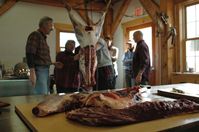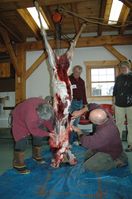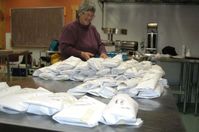The day began as a real drag. The previous afternoon, I’d killed a whitetail doe a long way from the truck. Too far, it turned out, to make it out with the deer before dark. My flashlight was in another jacket at home. So I pulled the doe beneath the boughs of a balsam tree to hide it from the ravens. My plan was to come back and get it in the morning.
The next day I started into the woods at daybreak. The deer was about a half-mile from the truck. I lashed it to a sturdy toboggan so it slid easily across the bare ground. In fact, the drag really wasn’t a drag—until I reached the ravine. We have some topographic ups and downs along the North Shore and this particular ravine is so steep and deep you can call it a canyon. Doe in tow, I had to traverse it to reach the truck.

Every year we haul a deer or two across the canyon–a physically demanding task—but this was the first time I’d done it alone. The outcome may have been different if the deer was a big buck rather than an average-sized doe, but grunting, groaning, huffing and puffing I made it across. I stacked the deer on top of two others already in the truck and headed for the North House Folk School in Grand Marais.
The rest of the day was spent with eight students who signed up to for my first-ever deer processing class. The class was initially scheduled for October, but had to be canceled when I was unable to come up with even road-killed deer. As most deer hunters know, endless mild weather has led to minimal deer activity this autumn. State conservation officer Mary Manning contributed a road-killed buck to the class and I hunted hard to come up with the doe. The third deer, a spike buck, was contributed by a friend with the caveat that he got to keep the processed meat.

Over the years, I’ve taught a number of folks how to process deer while working on whitetails in my garage. By no means a butcher, like many hunters I know how to bone out a deer and turn it into chops, roasts, stew meat and burger. I also know of only one way to learn this skill—with a knife in hand.
The students—two men and six women—had a mix of experiences and motivations for taking the class. Some were taking up hunting as adults. Others were interested in learning how to process deer so they could make use of road kill or whitetails given to them by hunter friends. One woman was taking the class to get meat from outside the agricultural food chain, because her boyfriend’s soy allergy prevents him from eating meat from an animal fed soy-based food. One woman was a former vegetarian who began hunting and added venison to her diet. All were “locavores,” people who prefer to eat food produced where they live.
Since this was a hands-on class, we started out by taking the doe from the truck and hanging it from a beam with a gambrel. Next the students removed the hide. We looked at the bullet damage near the wound and talked about lead contamination of the meat and of the environment. One student had found copper ammunition for her rifle, but the cost was prohibitively expensive, which led to a short discussion about how reloading can reduce costs and allow you to produce more ammo for target practice.

Then we started cutting up the carcass, removing the front shoulders, the backstraps and the tenderloins. The hindquarters were cut apart muscle by muscle. While some of the students worked on the carcass, others began cutting up the meat. Their first task was to trim away the tallow and membrane, then decide how to use the cut of meat. Trimmed backstraps were cut into chops. Tenderloins were left whole. Soon there were trays filling with roasts, stew meat and burger material.
We broke for lunch when all of the meat was removed from the doe carcass. When we came back, the men hung the buck carcass so the students who hadn’t had an opportunity to try skinning could do so. The kitchen became quiet as everyone went to work. However, the students kept me busy by asking questions, most of which were along the lines of “What should I do now?”
A lesson learned was that it is ok to toss some pieces into the scrap buckets, especially if you’ll spend 15 minutes trimming it to get an ounce or two of meat. They also learned how to assess the damage to a carcass and decide what to toss and what to save. On the road-killed buck, they made a good assessment of the damage where the animal was struck by the vehicle with little input from me.
We didn’t have time to cut up the third deer, the spike buck. As the afternoon wore on, the piles of venison were neatly wrapped and labeled. After helping with the kitchen clean-up, every student went home with a cooler containing the fruits of their labor. They were tired, but smiling. And even though some of them never intend to pick up a gun or buy a hunting license, the hunting fraternity gained some new recruits.



